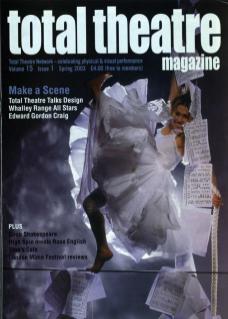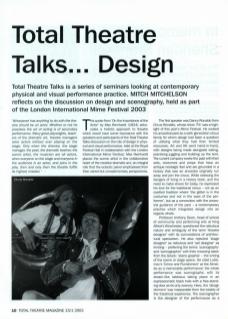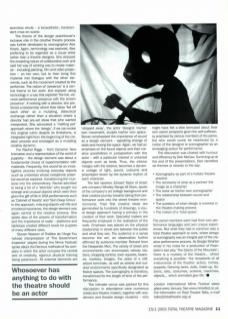‘Whosoever has anything to do with the theatre should be an actor. Whether or not he practises the art of acting is of secondary performance. Many great playwrights, teachers of the dramatic art, theatre managers were actors without ever playing on the stage. Only when the director, the stage manager, the poet, the dramatic teacher, the scenic artist, the musician are all actors, when everyone on the stage and everyone in the audience is an actor, and joins in the play, then and only then the theatre fulfils its highest mission.'
This quote from On the Importance of the Actor by Max Reinhardt (1924) advocates a holistic approach to theatre which would have some resonance with the speakers and participants of the Total Theatre Talks discussion on the role of design in physical and visual performance, held at the Royal Festival Hall in collaboration with the London International Mime Festival. Max Reinhardt places the scenic artist in the collaborative heart of the creative dramatic act, an integral role that the eclectic panel emphasised from their varied but complementary perspectives.
The first speaker was Danny Ronaldo from Circus Ronaldo, whose show Fili was a highlight of this year's Mime Festival. He evoked his ancestral past as a sixth-generation circus family for whom design had been a question of utilising what they had from limited resources. Art and life went hand-in-hand, with designs being made alongside eating, practising juggling and building up the tent. The current company evoke the past with their sets, costumes and props that have an antique nostalgic feel and are grounded in a history that saw an ancestor originally run away and join the circus. While stressing the dangers of living in a history book, and the need to make shows for today, he expressed his love for the traditional circus – not as an ossified tradition where ‘the glitter is in the costumes and not in the eyes of the performer', but as a connection with the ancestral guidance of the past – a contemporary practice which integrates design into an organic whole.
Professor Anthony Dean, head of school of community and performing arts at King Alfred's Winchester, questioned the nebulous nature and ambiguity of the term 'theatre designer' with its connotations of architectural specialism. He also rejected 'stage designer' as nebulous and ‘set designer’ as limiting – preferring the terms 'scenography’ and 'scenographer' with their meaning taken from the Greek: 'skeno graphia' – the writing of the scene or stage space. He cited Lublymov's Crime and Punishment at the Almeida as a memorable performance: the whole performance was scenographic with its dream-like tableaux taking place in an expressionistic black hole with a free-standing door as its only scenery. Here, the ‘design element' was inseparable from the totality of the theatrical experience. The scenographer is the designer of the performance as a seamless whole – a kinaesthetic, transcendent mise-en-scene.
The theme of the design practitioner's inclusive role in the creative theatre process was further developed by scenographer Alex Hoare. Again, terminology was explored, Alex preferring to be regarded as a visual artist rather than a theatre designer. She stressed the rewarding nature of collaborative work and said her way of working was to create material – including painting, film and video projection – on her own, but to then bring this material into dialogue with the other elements, such as the movement created by the performer. The notion of presence is a central theme to her work: she enjoyed using technology in a way that explored the live, visceral performance presence with the ‘screen presence'. If working with a director, she preferred a relationship where their ideas 'fed off each other as a mutating, dialectical exchange’ rather than a situation where a director had pre-set ideas that she wanted interpreted. She advocated a 'melting pot’ approach where the ‘design', if we can evoke this original rubric despite its limitations, is integrated right from the beginning of the creation process and envisaged as a mutating creative dynamic.
For Rachel Riggs – from Dynamic New Animation and a representative of the world of puppetry – the design element was about a fundamental choice of experimentation with materials. Frequently, this would be an investigative process involving everyday objects (such as umbrellas) whose metaphoric potential would be explored, transforming the mundane into the extraordinary. Rachel admitted to being a bit of a 'Womble' who sought out strange and unusual objects which were then given the gift of life in DNA performances such as Cabinet of Hearts and Skin Deep Circus! In this approach, imbuing objects with life and emotional resonance, the design element was again central to the creative process. She spoke also of the powers of transformation and the importance of scale – platforms and tabletops created different levels for puppets of many different sizes.
Steven Wasson of Théâtre de l'Ange Fou (whose interpretation of The Government Inspector played during the Mime Festival) spoke about the Decroux methods of his company in which the actor occupies the central axis of creativity, rigorous physical training being paramount. All external elements are 'stripped away', the actor ‘designs' his/her own movement, sculpts his/her own space. Steven emphasised the importance of sound as a design element – signalling change of state and moving the space. Again, we had an emphasis on the found objects and their creative possibilities in juxtaposition with the actor – with a particular interest in universal objects such as beds. Thus, the interior merges with the exterior, becomes a dynamic collage of light, sound, costume and prop/object driven by the dynamic rhythm of each character.
The last speaker, Edward Taylor of street arts company Whalley Range All Stars, spoke of the company's art college background and their creative journey towards taking their performance work into the street theatre environments. Their first creative ideas are germinated by hundreds of drawings, a visual design approach having a primacy in the creation of their work. Specialist makers are frequently employed in the realisation of the work. Emphasis was placed on the physical relationship in street arts between the public and what they see. The audience in a sense become the set, an observation further affirmed by audience-member Richard from the Desperate Men. The variety of street arts environments can encompass railway stations, shopping centres, town squares, beaches, markets, bridges, the sides of a cliff, airport terminals, as well as streets and outdoor environments specifically designated as festive spaces. The scenography is transitory, transformed for the length of time of the performance.
The intimate venue was packed for this discussion: in attendance were numerous artists and theatre-makers, together with academics and theatre design students – who might have felt a little bemused about their own career prospects given the self-sufficiency practised by various members of the panel, but who would surely be heartened by a notion of the designer or scenographer as an envisaging auteur for performance.
The discussion was chaired with humour and efficiency by Dick McCaw. Summing up at the end of the presentations, Dick identified six themes or strands to the day:
• Scenography as part of a holistic theatre practice
• The accessory or prop as a partner / the image as a character
• The actor as his/her own scenographer
• The relationship between sound and space
• The question of when design is involved in the theatre-making process
• The notion of a 'total space’
The panel members each had their own performance languages and own unique experiences. But what they had in common was a total theatre approach to work, where design or scenography was an integral part of the creative performance process. As Giorgio Strahler wrote in his notes for a production of Pirandello's last play The Giants of the Mountain there is a mystery of the theatre... where everything is possible: ‘the receptacle of all instruments of the theatre: actors, mimes, puppets, Dancing Jacks, dolls, make-up, illusions, sets, costumes, screens, machines, objects... which animated give life.'
The London International Mime Festival takes place every January. See www.mimefest.co.uk For information on Total Theatre Talks, e-mail talks@totaltheatre.org.uk


